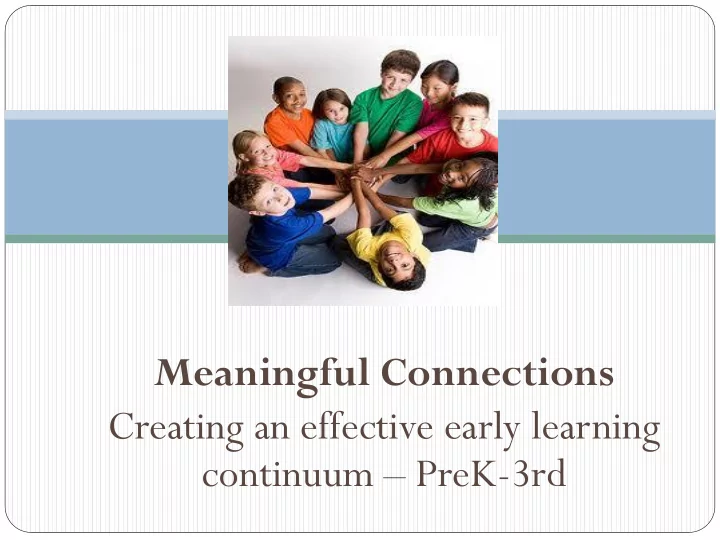

Meaningful Connections Creating an effective early learning continuum – PreK-3rd
Today’s Session Overview of PreK-3 rd and research supporting the benefits of a continuum approach for young learners Practical examples of effective practices with opportunities for you to reflect and consider their relevance for your role
Com ommu muni nity ty “We Change the World One Room At A Time Each Gathering Needs To Become An Example Of the Future We Want to Create. This Means That the Small Group is Where Transformation Takes Place” Peter Block
De Defin inin ing Pr PreK eK-3r 3rd PreK-3 rd The continuum of learning that spans the traditional boundaries of PreKindergarten programs (learning-based programs children experience in the years before school) and the early grades (K-3). K. Kauerz & National PreK-3 rd Partnership
For or Pr PreK eK Le Lear arne ners Develop Strong Foundational Skills Develop Social and Emotional Competence Establish Patterns Of Learning K. Kauerz & National PreK-3 rd Partnership
Wh Why y Pr PreK eK-3r 3rd
30 30 Mil illio ion n Wor ord d Ga Gap & & Di Disp spar arit itie ies s in in Ea Early y Voc ocab abular ulary y De Devel elop opme ment nt 1200 Cumulative Vocabulary (Words) College Educated Parents Working Class 600 Parents Low Income Parents 200 16 mos. 24 mos. 36 mos. Child’s Age (Months) Source: Hart & Risley (1995) 8
Tur urn n an and T d Tal alk How does this information resonate with you and how might it inform work?
Con once ceptuali ptualizin zing g Pr PreK eK-3r 3rd 3 rd Grade 2 nd Grade 1 st Grade VERTICAL Kindergarten Transitional Kindergarten Home with Private Community or Out of family may licensed district based home care have some centers and head start or with friend homes or neighbor group exp. State PreK HORIZONTAL
Com omponen onents ts 1. Mechanisms for building relationships & cross-sector alignment 2. Administrators and Leadership focused on quality instruction 3. Teacher Quality and Capacity 4. Instructional Tools and Practices
Compone onent nts s 5. Instructional Environment 6. Data and Assessments 7. Engaged Families 8. Transitions and Pathways
Fou ound ndat ation ions s for or a a susta sus tain inab abil ilit ity District program vision, goals and planning Reciprocal learning & leading Structured with representation of all roles across the continuum Attending to common understanding & terminology
Tran ansi siti tion on & Co & Conti ntinu nuit ity y Focuses on activities that support children and families as they move from one setting to another Sharon Kagan
Al Alig ignm nment ent Focuses on the context and pedagogy of instruction and instructional practice K. Kauerz & National PreK-3 rd Partnership
Tur urn n an and T d Tal alk Share an example of work where you are currently taking a pop-bead approach and/or one where you would like to see a shift from a building block to a pop-bead strategy?
From Research to Practice: San Mateo County Ready Schools - PreK-3 rd
Background • Funded primarily by First 5 San Mateo County • Co- lead and housed at Silicon Valley Community Foundation and San Mateo County Office of Education • Response to local and national research that investments in the early years are not sufficient on their own to ensure success by 3 rd grade • Ready Children, Ready Families, Ready Communities, Ready Schools
Bridges to Success San Mateo County Goals of the initiative: • All children enter school ready to learn • Experience a smooth transition to K and • Receive high quality, aligned early elementary education to prepare them for success by 3 rd grade
What factors contribute to readiness? Families Skill Child does Pre- at lower Girls Healthy 21 Age Info not have school risk special Children of needs families with Girls tend to be Children who are Children with Parents who *fewer* risks more ready for healthy, well-fed preschool are received like teen 8-11% of children have school than boys and well-rested much more readiness info mom, single special needs. Needs are are more ready. ready, transition had children parent, lost being identified earlier. Most children more easily, & who were job, frequent Almost all parents pursue more ready . have this basic have more moves, & few referrals and state that foundation, but advanced supports are services help. some have need. language skills. more ready. School Readiness
Percentage Scoring Proficient or Advanced in 3 rd Grade by Readiness Pattern
Disparities by income grow over time English Language Arts Math
Ready Schools Highlights • Leadership • Teacher Effectiveness • Data & assessment • Family Engagement
Ready Schools Highlights - Leadership • Ready Schools Teams Meet • Ready Schools Plans and school board policy adopted! • Preschool directors included in leadership councils • School-site level articulation and alignment
Ready Schools Highlights – Teacher Effectiveness • Joint professional development, including Common Core • Classroom observations • Meet and Greets
Ready Schools Highlights – Data and Assessment • PreK-K transition forms • Entering K assessments • Transition meetings • “Preschool attended” recorded in student info system
Ready Schools Highlights – Family Engagement • PreK-3 family literacy, science, math events • Chronic absence info • Consistent K Orientations • K Readiness Materials • Improved K registration processes • Educating families how to engage with schools
Opportunities for Common Core Standards (CCS) and PreK-3 • Ask your COE to provide a specific trainings on CCS for PreK and TK • Invite PreK/TK teachers to district level CCS Trainings • Use CCS as an opportunity to reach across grade levels to deepen communication and understanding about how young children learn
Questions?
ID IDENTI ENTIFY FY YOU OUR R NEX EXT STEPS EPS …. and share with a partner
CLOS OSURE URE Mary Seaton ~ Principal, NewVistas Consulting mary.s@newvistas.co Jessica Mihaly~ Initiative Officer, Silicon Valley Community Foundation jmihaly@siliconvalleycf.org
Recommend
More recommend